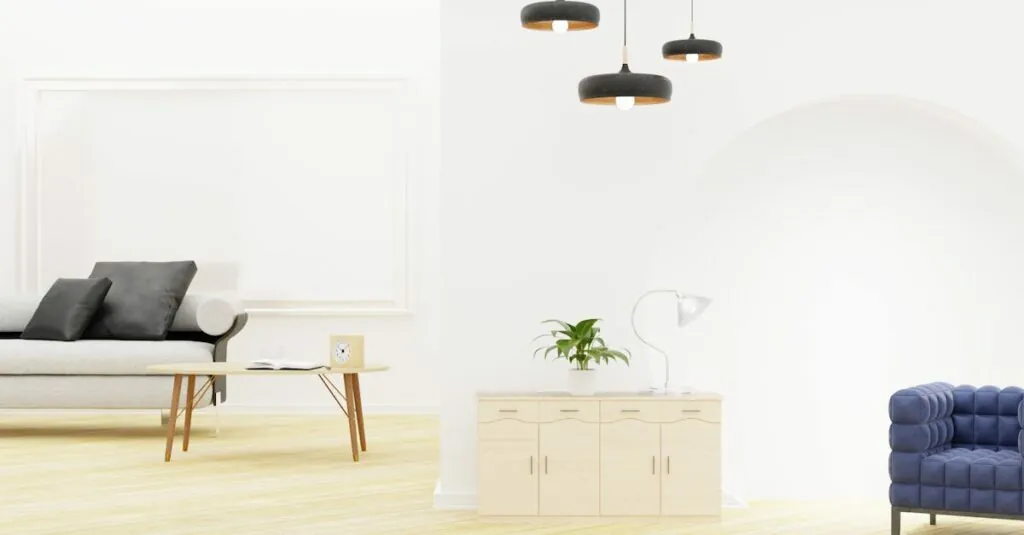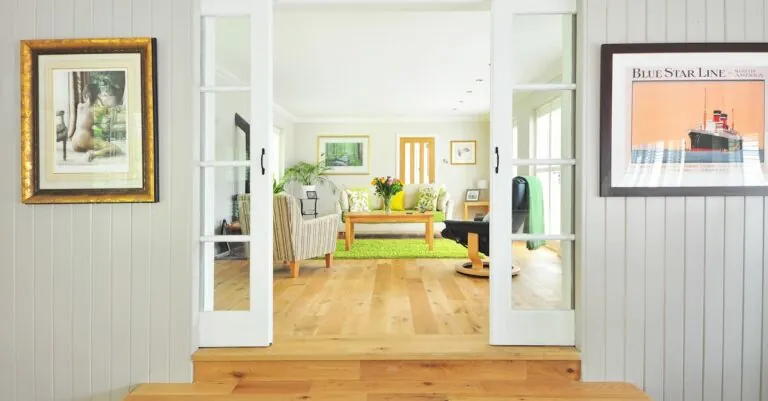Table of Contents
ToggleIn a world where clutter reigns supreme, embracing minimalist living can feel like finding a unicorn in a haystack. Imagine a living room that’s not just a space to crash after a long day but a serene sanctuary that whispers “relax” every time you step inside. With the right minimalist touches, it’s possible to transform your chaotic haven into a stylish retreat that even Marie Kondo would applaud.
Understanding Minimalist Living Room Design
Minimalist living room design focuses on simplicity and functionality. This approach eliminates unnecessary elements to create a serene atmosphere.
Key Principles of Minimalism
Less is more in minimalist design. Clutter-free spaces feature a limited color palette that promotes tranquility. Multifunctional furniture optimizes space, offering storage without sacrificing style. Natural light enhances openness, making rooms feel larger and more inviting. Thoughtful decor serves a purpose; each piece contributes to the overall aesthetic without overwhelming it.
Benefits of Minimalist Living Spaces
Minimalist living spaces reduce stress by decluttering environments. These spaces foster relaxation by providing a calm retreat away from daily chaos. Simplicity enhances focus, allowing for better concentration on activities. Maintenance becomes easier with fewer items to clean or organize. Financial savings accumulate, thanks to decreased expenditure on unnecessary items and furniture purchases.
Color Palettes for Minimalist Living Rooms
Minimalist living rooms thrive on carefully chosen color palettes. A focus on color enhances tranquility and promotes an organized, calming atmosphere.
Neutral Tones and Their Impact
Neutral tones serve as the foundation for minimalist living rooms. Shades like white, beige, and soft gray create a serene backdrop, allowing space to feel larger and brighter. Natural light reflects beautifully off these soft shades, contributing to openness. Designers often recommend these tones to foster relaxation and focus. Furthermore, minimal decoration can stand out against a neutral palette, emphasizing key elements in the room.
Accent Colors and Their Use
Accent colors add depth and interest to minimalist designs. Choosing one or two bold hues, such as deep blue or rich green, can create striking focal points. These colors work effectively in accessories like cushions, artwork, or decorative vases. Targeting accents carefully ensures they enhance without overwhelming the tranquility of the room. This thoughtful approach draws attention to specific areas while maintaining an overall minimalist ethos.
Furniture Selection for Minimalist Living Rooms
Furniture selection plays a crucial role in achieving a minimalist living room. Prioritizing functionality helps create a cohesive and serene environment.
Choosing Functional Pieces
Opt for furniture that serves multiple purposes. Sofas with built-in storage can decrease clutter while maintaining comfort. Coffee tables that double as storage units enhance organization without sacrificing style. Select chairs that complement the overall design yet provide adequate seating. Additionally, consider foldable or extendable pieces, as they adapt to various needs without overcrowding the space. Prioritize quality over quantity with each furniture item, ensuring that it aligns with the minimalist ethos.
Importance of Scale and Proportion
Scale and proportion significantly impact the aesthetic of a minimalist living room. Choose larger furniture for big spaces to create balance, while smaller rooms benefit from sleek, low-profile pieces. Maintain harmony by considering the room’s dimensions; oversized items can overwhelm, while tiny pieces may look lost. Visual space also matters—aim for adequate room between furniture for easy movement. Cohesiveness grows by ensuring items relate in size and shape, reinforcing the minimalist approach while enhancing functionality.
Decor and Accessories
Minimalist decor and accessories enhance the serene atmosphere of a living room. Selecting purposeful elements transforms spaces into inviting havens.
Minimalist Artwork Ideas
Choose artwork that resonates with the minimalist ethos. Abstract prints and monochromatic pieces showcase simplicity while adding character. Opt for large-scale canvases over multiple small items to maintain visual coherence. Black and white photography also offers an elegant touch without overwhelming the aesthetic. It’s essential to curate art that reflects personal taste while adhering to minimalist principles. Display artwork with ample whitespace around it; this approach emphasizes its impact within the room.
Incorporating Plants in a Minimalist Space
Incorporate plants strategically to breathe life into a minimalist living room. Select low-maintenance varieties, like snake plants or succulents, that provide greenery without excessive care. Use simple, unobtrusive pots that align with the room’s color palette for a seamless look. Position plants at varying heights to create interest and depth without cluttering the space. Natural elements contribute to a calming atmosphere while purifying indoor air. Embrace the balance between nature and minimalism to enhance overall tranquility in the room.
Layout and Space Optimization
Optimizing layout and space enhances the minimalist living room experience. Prioritizing openness creates an inviting and airy environment.
Open Concept Living
Embracing open concept living maximizes natural light and promotes seamless flow between spaces. Combining the living room, dining area, and kitchen fosters a sense of unity. Selecting lightweight furniture maintains visual continuity, making spaces feel more connected. Allocating defined pathways ensures easy movement throughout the area. Large windows invite generous sunlight, enhancing the overall ambiance. Utilizing a cohesive color palette reinforces the tranquil environment, contributing to a calming aesthetic.
Creating Zones in a Minimalist Room
Defining zones within a minimalist room emphasizes functionality while maintaining simplicity. Designating areas for relaxation, work, and socializing helps organize daily activities. Using rugs effectively separates these zones, adding warmth and texture. Each designated space encourages distinct purposes while preserving an uncluttered appearance. Arranging furniture to face one another promotes interaction without overcrowding. Incorporating multifunctional pieces, like ottomans that offer additional seating, ensures practicality. Maintaining sufficient space between zones fosters a sense of openness, allowing each area to breathe.
Embracing minimalist living room ideas can significantly enhance one’s home environment. By prioritizing simplicity and functionality, individuals can create a space that promotes relaxation and clarity. Thoughtful furniture selection and a carefully curated color palette play vital roles in achieving this serene atmosphere.
Incorporating purposeful decor and maintaining openness within the layout further enriches the minimalist experience. As a result, a well-designed minimalist living room not only looks stylish but also fosters a sense of peace and organization. Those who adopt these principles will likely find their homes transformed into tranquil sanctuaries that support a balanced lifestyle.








